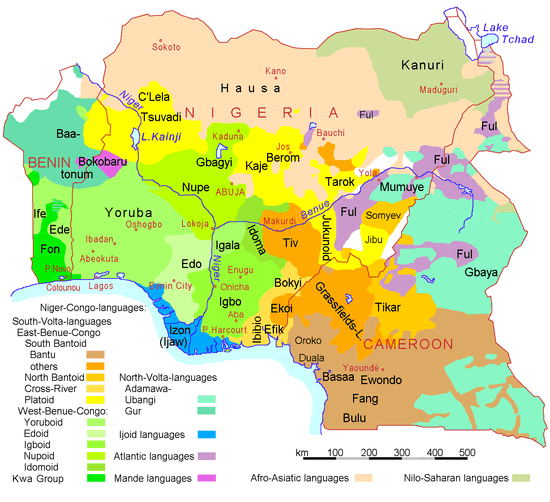Edo language
Edo /ˈɛdoʊ/[3] (with diacritics, Ẹ̀dó), also called Bini (Benin), is a Volta–Niger language spoken in Edo State, Nigeria. It is the primary native language of the Edo people and was the primary language of the Benin Empire and its predecessor, Igodomigodo.
| Edo | |
|---|---|
| Bini | |
| Ẹ̀dó | |
| Native to | Nigeria |
| Region | Edo State |
| Ethnicity | Edo people |
Native speakers | 1.6 million (2015)[1] |
Niger–Congo
| |
| Latin | |
| Language codes | |
| ISO 639-2 | bin |
| ISO 639-3 | bin |
| Glottolog | bini1246[2] |
 Linguistic map of Benin, Nigeria, and Cameroon. Edo is spoken in southern Nigeria. | |
Phonology
Vowels
There are seven vowels, /i e ɛ a ɔ o u/, all of which may be long or nasal, and three tones.
Consonants
Edo has a rather average consonant inventory for an Edoid language. It maintains only a single phonemic nasal, /m/, but has 13 oral consonants, /ɺ, l, ʋ, j, w/ and the 8 stops, which have nasal allophones such as [n, ɲ, ŋʷ] before nasal vowels.
| Labial | Labiodental | Alveolar | Palatal | Velar | Labio-velar | Glottal | |
|---|---|---|---|---|---|---|---|
| Nasal | m | ||||||
| Plosive | p b [pm bm] |
t d [tn dn] |
k ɡ [kŋ ɡŋ] |
k͡p ɡ͡b [k͡pŋ͡m ɡ͡bŋ͡m] |
|||
| Fricative | f v | s z | x ɣ | h | |||
| Close approximant | ɹ̝̊ ɹ̝ | ||||||
| Open approximant | ʋ [ʋ̃] |
l ɹ [n ɾ̃] |
j [ɲ] |
w [ŋʷ] |
The three rhotics have been described as voiced and voiceless trills as well as a lax English-type approximant. However, Ladefoged[4] found all three to be approximants, with the voiced–voiceless pair being raised (without being fricatives) and perhaps at a slightly different place of articulation compared to the third but not trills.
Phonotactics
Syllable structure is simple, being maximally CVV, where VV is either a long vowel or /i, u/ plus a different oral or nasal vowel.
Orthography
The Edo alphabet has separate letters for the nasalised allophones of /ʋ/ and /l/, mw and n:
| A | B | D | E | Ẹ | F | G | Gb | Gh | H | I | K | Kh | Kp | L | M | Mw | N | O | Ọ | P | R | Rh | Rr | S | T | U | V | Vb | W | Y | Z |
| /a/ | /b/ | /d/ | /e/ | /ɛ/ | /f/ | /ɡ/ | /ɡb/ | /ɣ/ | /h/ | /i/ | /k/ | /x/ | /kp/ | /l/ | /m/ | /ʋ/ | /l/ | /o/ | /ɔ/ | /p/ | /ɹ/ | /ɹ̝̊/ | /ɹ̝/ | /s/ | /t/ | /u/ | /v/ | /ʋ/ | /w/ | /j/ | /z/ |
Long vowels are written by doubling the letter. Nasal vowels may be written with a final -n or with an initial nasal consonant. Tone may be written with acute accent, grave accent, and unmarked, or with a final -h (-nh with a nasal vowel).
See also
- Edo people
- Benin Empire
References
- Edo at Ethnologue (21st ed., 2018)
- Hammarström, Harald; Forkel, Robert; Haspelmath, Martin, eds. (2017). "Bini". Glottolog 3.0. Jena, Germany: Max Planck Institute for the Science of Human History.
- Laurie Bauer, 2007, The Linguistics Student's Handbook, Edinburgh
- Ladefoged, Peter; Maddieson, Ian (1996). The Sounds of the World's Languages. Oxford: Blackwell. ISBN 978-0-631-19815-4.
External links
- Edo Language Dictionary Online
- Hans Melzian's Edo-English Dictionary
- Rebecca Agheyisi's Edo-English Dictionary
- Centre for Edo Studies
- PanAfrican L10n page on Edo (Bini)
- Edo/Africa names dictionary{source Edoworld}
- Bini (Edo) wordlists and recordings at the UCLA Phonetics Archive
- Bini (Edo) Market Days Calender [sic] on Naija local